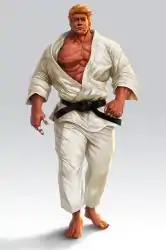Judoka (5e Subclass)
Not all warriors use weapons to defeat their opponents. Some prefer to get in close enough that their opponent's weapons are rendered ineffective, and then press the advantage to take them out of the fight. Such fighters are often taken for monks, and indeed they have many similarities; however, the Judoka does not study the art of ki, instead spending their time in pursuit of mastery over their own bodies - as well as those of their enemies.
 |
|---|
| "Go ahead. Take your best shot." |
Martial Arts
When you choose this archetype at 3rd level, you learn the art of unarmed combat - much like a monk. However, your martial art has some key differences. You gain the following benefits:
- While unarmed, one or both of your fists may qualify as a light melee weapon for the purposes of your Fighting Style and two-weapon fighting.
- You can roll a d4 in place of the normal damage of your unarmed strike. This damage die increases with your level, as shown on the table below.
- When you use the Attack action to shove a creature, you may deal bludgeoning damage as though you had hit it with an unarmed strike, in addition to the normal effects of the shove. Also, you may move that creature to any square adjacent to you before it is subjected to the effects of the shove; and you may choose to cause both effects of the shove at once, pushing the target 5 feet and rendering it prone simultaneously.
| Fighter Level | Martial Arts | |
|---|---|---|
| 3rd | 1d4 | |
| 5th | 1d6 | |
| 11th | 1d8 | |
| 17th | 1d10 | |
| ||
The Rhythm of Movement
At 7th level, your rigorous training begins to bear fruit, and you start to grasp the beautiful intricacies of the movement of the human body. You gain proficiency in Athletics. If you already have proficiency in Athletics, your proficiency bonus is doubled for any ability check you make that uses Athletics. Additionally, if you study another creature's movements for 1 round, you can ascertain that creature's attitude toward you (friendly, indifferent, or hostile). This ability cannot penetrate magically obscured intent.
Conquer by Yielding
At 10th level, you learn to use the aggression of your opponents against them. When a creature within 5 feet of you misses you with a melee attack, you can spend your reaction to immediately attempt a shove against that creature. If you succeed on the check, in addition to the normal effects of the shove, and the extra effects bestowed by Martial Arts, you may deal bludgeoning damage to the creature equal to its own Strength modifier.
The Stone Around Which the River Flows
At 15th level, your mastery of momentum enables you to throw around larger foes with relative ease. You can now grapple and shove creatures of up to 2 size categories larger than you. Additionally, when you shove a creature no more than 1 size category larger than you, you may choose to push that creature an additional 5 feet for every 5 points by which your check exceeds theirs.
Force Conduit
At 18th level, you become so skilled in the art of well-placed throws and hits that even the sturdiest armor cannot protect your foes. As a bonus action, you can enter a stance which causes your unarmed strikes to deal force damage (rather than bludgeoning) until the start of your next turn. Additionally, while in this stance, you may use Conquer by Yielding once per round without spending your reaction. This stance lasts until the start of your next turn or until you are rendered prone (whichever comes first).
Back to Main Page → 5e Homebrew → Character Options → Subclasses